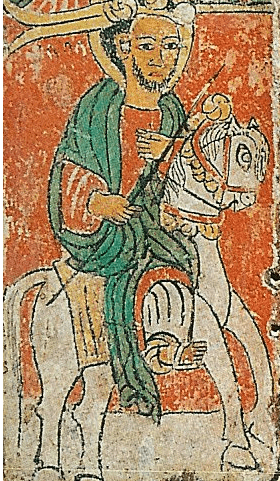Lalibela (Emperor of Ethiopia) facts for kids
Quick facts for kids Lalibela |
|
|---|---|

15th-century painting of Emperor Lalibela
|
|
| Reign | 1181 – 1221 |
| Predecessor | Kedus Harbe |
| Successor | Na'akueto La'ab |
| Born | 1162 Adefa, Roha or Bugna, Ethiopia |
| Died | 1221 (aged 58–59) |
| Spouse | Masqal Kibra |
| Issue | Yetbarak |
| Dynasty | Zagwe dynasty |
| Father | Jan Seyum |
| Religion | Ethiopian Orthodox Tewahedo |
Lalibela (Ge'ez: ላሊበላ), whose real name was Gebre Meskel (gäbrä mäsqäl), was a powerful ruler of Ethiopia. He was an Emperor of Ethiopia from the Zagwe dynasty. He ruled from 1181 to 1221. Many people believe he was the son of Jan Seyum and the brother of Kedus Harbe. Lalibela is famous for the amazing monolithic churches carved out of rock in the city named after him, Lalibela. He is considered a saint by the Orthodox Tewahedo churches.
Contents
Emperor Lalibela
Early Life and Rise to Power
King Lalibela was born in 1162 AD. He was born in either Adefa or Roha, which was later renamed Lalibela. When he was born, a swarm of bees surrounded him. His mother saw this as a special sign. She believed it meant he would become the Emperor of Ethiopia. So, they gave him the name "Lalibela." This name means "the bees recognize his sovereignty" in the old Agaw language.
Tradition says that Lalibela had to leave his home for a while. This was because his uncle and his brother, King Kedus Harbe, were not friendly towards him. Some stories even say his half-sister tried to poison him. Historians think Lalibela might have taken power by force. This is because he became king while his brother was still alive.
Building the Rock-Hewn Churches
Lalibela is famous for building 11 churches carved directly from solid rock. These churches are in the city of Lalibela. Legend says he had a vision of Jerusalem. After this, he wanted to build a "new Jerusalem" in Ethiopia. This was especially important after Muslims captured the old Jerusalem in 1187.
Because of this vision, many places in Lalibela have Biblical names. For example, the town's river is called the River Jordan. Lalibela served as the capital city of Ethiopia for many years. It was the capital from the late 12th century into the 13th century.
The exact details of how these amazing churches were built are not fully known. A book about his life, called the Gadla Lalibela, says that angels helped him carve them. Priests in Lalibela told a Portuguese visitor in the 1500s that the churches took 24 years to build. They said King Lalibela ordered this huge project.
His Queen, Masqal Kibra
Lalibela's main queen was named Masqal Kibra. She was a very influential person. Some stories say she convinced a religious leader, Abuna Mikael, to make her brother a bishop. Later, this Abuna Mikael left Ethiopia. He complained that her brother had taken over his power.
Another story says she convinced King Lalibela to give up his throne. He supposedly gave it to his nephew, Na'akueto La'ab. But after 18 months, his nephew did not rule well. So, Masqal Kibra convinced Lalibela to become king again. Some historians think this story might hide a short time when his nephew actually took power. They believe Lalibela's son, Yetbarak, ended his nephew's rule. Masqal Kibra is also credited with building one of the rock churches, Bet Abba Libanos. She built it as a memorial for Lalibela after he died.
Legacy and Records
Not much is known about other Zagwe kings. However, many records about Lalibela's reign still exist. Besides the Gadla Lalibela, there are other accounts. For example, a group from the Greek Orthodox Patriarch of Alexandria visited Lalibela's court around 1210. They wrote about him, Na'akueto La'ab, and Yetbarak. An Italian scholar, Carlo Conti Rossini, also published records of land grants from Lalibela's time.
See also
In Spanish: Gebre Mesqel Lalibela para niños

